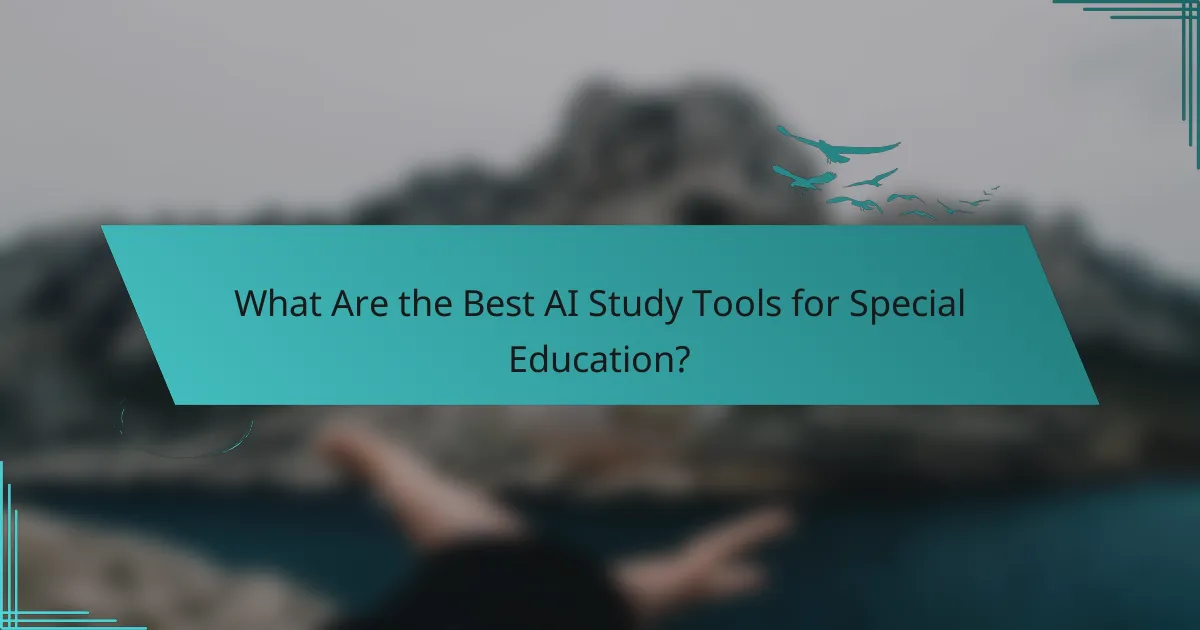AI study tools designed for special education provide personalized learning experiences that cater to the unique needs of each student. By leveraging advanced algorithms and data analysis, these tools enhance engagement and accessibility, ensuring that learners with diverse disabilities receive the support they need to succeed academically.

What Are the Best AI Study Tools for Special Education?
The best AI study tools for special education cater to diverse learning needs, offering personalized support that enhances educational outcomes. These tools leverage technology to assist students with various disabilities, ensuring they have equal access to learning resources.
Tools like Kurzweil 3000
Kurzweil 3000 is designed to support students with reading difficulties, such as dyslexia. It offers features like text-to-speech, highlighting, and note-taking capabilities, allowing learners to engage with content more effectively.
When using Kurzweil 3000, consider its compatibility with different formats, including PDFs and web pages. This flexibility enables students to access a wide range of materials. Additionally, the program supports multiple languages, which can be beneficial in diverse classrooms.
Tools like Read&Write
Read&Write is another powerful tool that assists students with writing and comprehension challenges. It provides features such as word prediction, speech recognition, and a built-in dictionary, making it easier for learners to express their ideas.
This tool is particularly useful for students who struggle with spelling and grammar. By offering real-time feedback, Read&Write helps users improve their writing skills while building confidence. Integration with popular platforms like Google Docs enhances its usability in various educational settings.
Tools like Ghotit
Ghotit specifically targets individuals with dyslexia and dysgraphia, offering advanced spelling and grammar correction tailored to their needs. It recognizes common errors made by these learners and provides suggestions for improvement.
Using Ghotit can significantly reduce frustration during writing tasks. Its contextual spell checker and grammar checker help ensure that students produce clearer and more accurate written work. This tool is particularly effective for older students and adults who require additional support in academic and professional environments.

How Do AI Study Tools Personalize Learning?
AI study tools personalize learning by adapting content and approaches to meet the unique needs of each student. These tools utilize advanced algorithms and data analysis to create tailored educational experiences that enhance engagement and improve outcomes for learners, particularly those with special education needs.
Adaptive learning algorithms
Adaptive learning algorithms adjust the difficulty and type of content presented to students based on their individual performance. For example, if a student struggles with a specific math concept, the algorithm may provide additional practice problems or alternative explanations until mastery is achieved.
These algorithms often employ techniques such as item response theory, which predicts a learner’s ability based on their responses. This allows for a more personalized learning path, ensuring that students are neither bored with material that is too easy nor overwhelmed by content that is too challenging.
Data-driven insights
Data-driven insights are crucial for understanding student progress and tailoring educational strategies. AI tools collect and analyze data on student interactions, learning speeds, and comprehension levels, providing educators with actionable feedback.
For instance, teachers can access reports that highlight areas where students excel or struggle, enabling them to adjust their teaching methods accordingly. This data can also inform decisions about resource allocation, ensuring that support is directed where it is most needed.

What Are the Benefits of AI in Special Education?
AI in special education offers significant advantages by personalizing learning experiences to meet individual needs. These benefits include improved engagement, tailored content delivery, and enhanced accessibility for students with diverse learning requirements.
Improved engagement
AI tools can significantly boost student engagement by providing interactive and adaptive learning experiences. For instance, gamified learning platforms can capture the interest of students who may struggle with traditional methods, making lessons more enjoyable and effective.
Additionally, AI can analyze student behavior and preferences, adjusting content in real-time to maintain interest. This personalized approach helps keep students focused and motivated, leading to better learning outcomes.
Tailored content delivery
AI enables the customization of educational materials to suit individual learning styles and paces. For example, students with reading difficulties may benefit from text-to-speech features, while others may require visual aids to grasp concepts more effectively.
By assessing a student’s progress and understanding, AI can recommend specific resources or activities that align with their unique needs, ensuring that each learner receives the appropriate level of challenge and support.
Enhanced accessibility
AI technologies can greatly enhance accessibility for students with special education needs by providing tools that accommodate various disabilities. Features such as speech recognition, alternative input methods, and customizable interfaces can make learning more inclusive.
Moreover, AI can help educators identify and address barriers to learning by analyzing data on student performance and engagement. This proactive approach allows for timely interventions, ensuring that all students have equal opportunities to succeed in their educational journey.

What Criteria Should You Consider When Choosing AI Tools?
When selecting AI tools for personalized learning outcomes in special education, consider user-friendliness, integration capabilities, and cost-effectiveness. These criteria will help ensure that the tools are accessible, compatible with existing systems, and financially viable for your educational setting.
User-friendliness
User-friendliness is crucial for ensuring that both educators and students can effectively engage with AI tools. Look for interfaces that are intuitive and require minimal training. Tools that offer customizable settings can cater to individual learning needs, making them more effective for special education.
Consider tools that provide clear instructions and support resources. For example, platforms with built-in tutorials or help centers can significantly enhance usability, especially for those unfamiliar with technology.
Integration capabilities
Integration capabilities refer to how well an AI tool can work with existing educational systems and software. Choose tools that can seamlessly connect with learning management systems (LMS), student information systems, and other educational technologies. This ensures that data flows smoothly and reduces administrative burdens.
Evaluate whether the AI tool supports common standards like IMS Global or SCORM, which facilitate interoperability. Tools that can integrate with platforms like Google Classroom or Microsoft Teams can enhance collaboration and streamline workflows.
Cost-effectiveness
Cost-effectiveness is a key factor when selecting AI tools, especially in budget-conscious educational environments. Assess not only the initial purchase price but also ongoing costs such as subscriptions, maintenance, and training. Look for tools that offer tiered pricing models to accommodate different budgets.
Consider the potential return on investment (ROI) by evaluating how the tool can improve learning outcomes and save time for educators. Free trials or pilot programs can provide insights into the tool’s effectiveness before committing to a purchase.

How Do AI Tools Support Different Learning Disabilities?
AI tools enhance learning for students with disabilities by providing personalized resources and adaptive learning experiences. These technologies cater to individual needs, allowing for tailored instruction that can significantly improve engagement and comprehension.
Support for dyslexia
AI tools for dyslexia focus on improving reading skills through features like text-to-speech and phonetic spelling assistance. These tools can break down words into phonemes, helping students understand pronunciation and meaning.
For example, applications that highlight text as it is read aloud can aid in maintaining focus and improving retention. Additionally, customizable fonts and background colors can reduce visual stress, making reading more accessible.
Support for ADHD
AI technologies assist students with ADHD by offering structured learning environments and minimizing distractions. Tools that use gamification can keep students engaged while providing immediate feedback, which is crucial for maintaining attention.
Consider using apps that allow for short, focused learning sessions, typically lasting around 10-15 minutes, followed by breaks. This approach can help sustain concentration and improve information retention.
Support for autism spectrum disorders
AI tools designed for students with autism spectrum disorders often include social skills training and communication aids. These applications can simulate social interactions, helping students practice and understand social cues in a safe environment.
Visual supports, such as schedules and visual timers, can also be integrated into AI tools to provide clear expectations and reduce anxiety. Using these tools consistently can foster independence and improve daily functioning for students on the spectrum.

What Are the Challenges of Implementing AI in Special Education?
Implementing AI in special education presents several challenges, including data privacy concerns, the need for tailored algorithms, and the integration of technology into existing educational frameworks. These obstacles can hinder the effective use of AI tools designed to support students with special needs.
Data Privacy and Security Concerns
Data privacy is a significant challenge when using AI in special education. Schools must ensure that sensitive information about students is protected and complies with regulations like FERPA in the U.S. or GDPR in Europe. This often requires robust data management systems and policies to safeguard personal data.
Additionally, parents and guardians may be hesitant to allow AI tools to collect data on their children. Clear communication about how data will be used and the benefits of AI can help alleviate these concerns.
Need for Tailored Algorithms
AI systems need to be specifically designed to address the diverse learning needs of students with disabilities. Generic algorithms may not provide the necessary support, leading to ineffective learning outcomes. Developers must work closely with educators and specialists to create customized solutions that cater to individual learning profiles.
For instance, an AI tool that adapts reading materials based on a student’s comprehension level can significantly enhance learning. However, developing such tailored algorithms requires extensive research and collaboration.
Integration with Existing Educational Frameworks
Integrating AI tools into existing educational frameworks can be complex. Educators may face challenges in adapting their teaching methods to incorporate new technologies effectively. Professional development and training are essential to ensure teachers are comfortable using AI tools in their classrooms.
Moreover, schools must consider the financial implications of adopting AI solutions, including costs for software, training, and ongoing support. Budgeting for these expenses is crucial to successful implementation.
